7 Key Reasons to Support the Ban on Parabens and Formaldehyde in Cosmetics

Overview
The article underscores the critical need to ban parabens and formaldehyde in cosmetics, highlighting their significant health risks, including hormone disruption and potential cancer links, alongside their harmful environmental effects.
Extensive research supports this argument, revealing the widespread presence of these substances in beauty products and their associated health hazards.
This situation underscores an urgent call for regulatory action aimed at safeguarding consumer safety and fostering the adoption of safer alternatives within the industry.
Introduction
The use of parabens and formaldehyde in cosmetics has ignited a significant debate, particularly due to their widespread role as preservatives and the considerable health risks they present. Research has linked these chemicals to hormone disruption and an elevated risk of cancer, intensifying the call for a ban on their use in beauty products.
This article explores the compelling reasons behind the demand for stricter regulations, emphasizing the advantages of eliminating these detrimental ingredients for both consumer safety and environmental health.
As awareness continues to rise, the pressing question emerges: how can the cosmetics industry effectively adapt to fulfill the demand for safer alternatives while ensuring adherence to evolving regulations?
AVS Life Sciences: Ensuring Compliance with the Ban on Parabens and Formaldehyde in Cosmetics
AVS Life Sciences plays a crucial role in assisting cosmetic producers in navigating the complexities of the . As a dedicated partner for across biopharmaceuticals, medical devices, and nutraceuticals, AVS collaborates with clients to formulate effective strategies that meet current regulations. This process encompasses:
- to educate teams on evolving regulatory requirements
- Meticulous documentation that aligns with industry standards
Notably, the FDA classifies these preservatives as at concentrations up to 25%, while the European Union has established limits of 0.4% for any individual compound and 0.8% for total concentrations. Furthermore, the Danish government has prohibited the use of , which emphasizes the importance of the ban parabens/formaldehyde cosmetics bill amid the increasing .
By adopting a hands-on approach, AVS Life Sciences empowers clients to successfully while . This commitment to excellence not only fosters trust but also positions clients for .

Health Risks: Understanding the Dangers of Parabens and Formaldehyde in Cosmetics
Parabens and formaldehyde serve as prevalent preservatives in cosmetics, yet they pose significant . Research has established a clear connection between , potentially leading to reproductive issues and an increased risk of cancer. For instance, some preservatives are known to mimic estrogen, which may stimulate breast cell growth and contribute to breast cancer development. Alarmingly, research indicates that over 90% of the U.S. population has measurable amounts of these preservatives in their bodies, raising serious concerns regarding . Furthermore, , amplifying concerns for overall health.
Formaldehyde, classified as a known carcinogen, presents additional dangers. It can induce skin irritation and respiratory problems, particularly among individuals with sensitivities. The widespread concerns related to formaldehyde among cosmetic users highlight . Reports suggest that and long-term medical issues.
Understanding these risks is essential for individuals aiming to make regarding their personal care products. Producers, too, must prioritize in their formulations, considering the mounting evidence linking these preservatives to . As awareness increases, the demand for for stricter regulations on the use of preservatives and formaldehyde in beauty products becomes increasingly urgent.
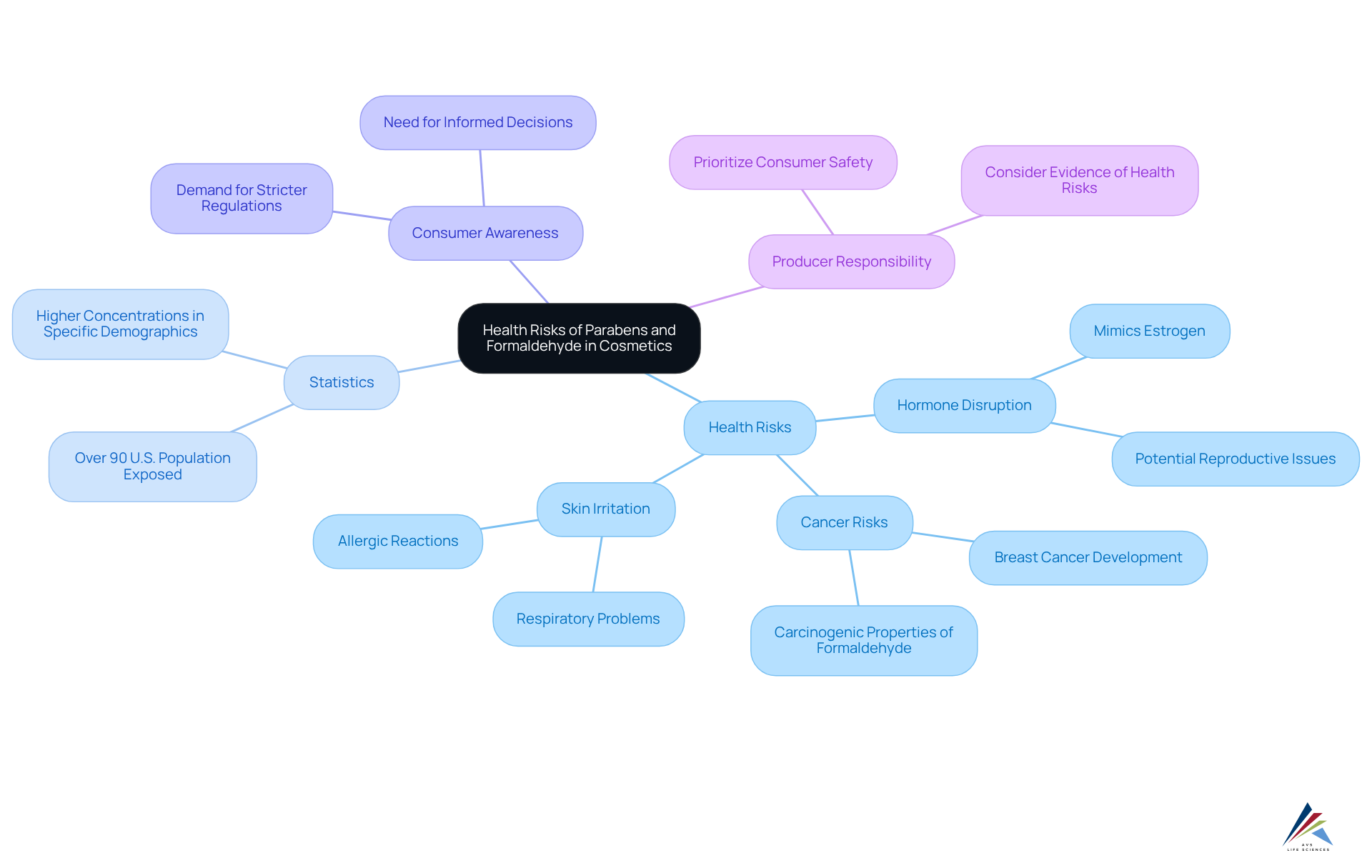
Environmental Concerns: The Impact of Parabens and Formaldehyde on Ecosystems
The inclusion of preservatives and formaldehyde in cosmetics poses significant dangers, which is why the is crucial for protecting both and the environment. Parabens, which are commonly found in personal care products, can accumulate in aquatic systems, leading to . Research indicates that in fish; studies demonstrate that propylparaben and its mixtures exhibit greater toxicity than methylparaben alone. This toxicity can alter , a crucial indicator species for assessing water quality, underscoring the urgent need for .
Formaldehyde, conversely, has been shown to in terrestrial ecosystems. Its presence in the environment can lead to reduced plant vitality, which subsequently impacts the entire food web. Ecologists emphasize that the introduction of such chemicals into ecosystems can have cascading effects, disrupting not only individual species but also the intricate relationships that sustain biodiversity.
Addressing these environmental concerns is crucial for promoting within the beauty industry, particularly in the context of the ban parabens/formaldehyde cosmetics bill. By reducing or eliminating the use of , we can and ensure the health of our planet for future generations.

Consumer Advocacy: The Push for Safer Cosmetics and Regulatory Change
have been instrumental in championing the to prohibit these substances in beauty products. These organizations raise awareness about the potential dangers posed by these chemicals and actively lobby for , including the ban parabens/formaldehyde cosmetics bill. This act aims to enhance FDA authority and introduce like facilities registration and safety substantiation. Their efforts have led to a , prompting producers to redesign items to meet the public's demand for .
Recent surveys indicate that a significant majority of consumers—over 63%—consider when selecting beauty products, while 74% regard organic ingredients as crucial in personal care items. Engaging with consumer advocacy not only aids companies in complying with regulations but also fosters trust with their customer base.
As Janet Nudelman, Director of BCPP’s Campaign for Safe Cosmetics, asserts, "We couldn’t be more excited to introduce them to key White House officials and members of Congress who we know will appreciate their dedication to raising a ."
This collaboration is vital as the industry transitions towards , particularly with the impending regulations set to take effect in 2025.

Regulatory Landscape: Current Laws and the Need for Stricter Cosmetic Safety Standards
The regulatory environment for beauty products is undergoing significant transformation, driven by mounting demands for . Numerous countries have begun imposing restrictions through the , targeting substances linked to serious health risks. Notably, over 1,400 substances have been prohibited or limited in beauty products across various countries, while the U.S. has only banned nine, underscoring a substantial disparity in consumer safety. This gap highlights the urgent need for , including the ban parabens/formaldehyde cosmetics bill, to ensure the safety of all beauty product ingredients.
Experts assert that the current U.S. regulatory framework is reactive rather than precautionary, often prioritizing manufacturers over . As noted by industry supporters, many Americans remain unaware of the untested and potentially hazardous substances present in their beauty products. This situation calls for and advocacy for the ban parabens/formaldehyde cosmetics bill to promote more robust regulations.
In response to these challenges, companies are adapting to , with major retailers such as CVS Health and Target pledging to eliminate from their store-brand products. These initiatives reflect a growing recognition of the importance of public safety and .
To effectively , manufacturers must stay vigilant and informed. in understanding and adapting to these regulatory demands, ensuring that businesses can protect public health while maintaining compliance in a rapidly changing landscape.
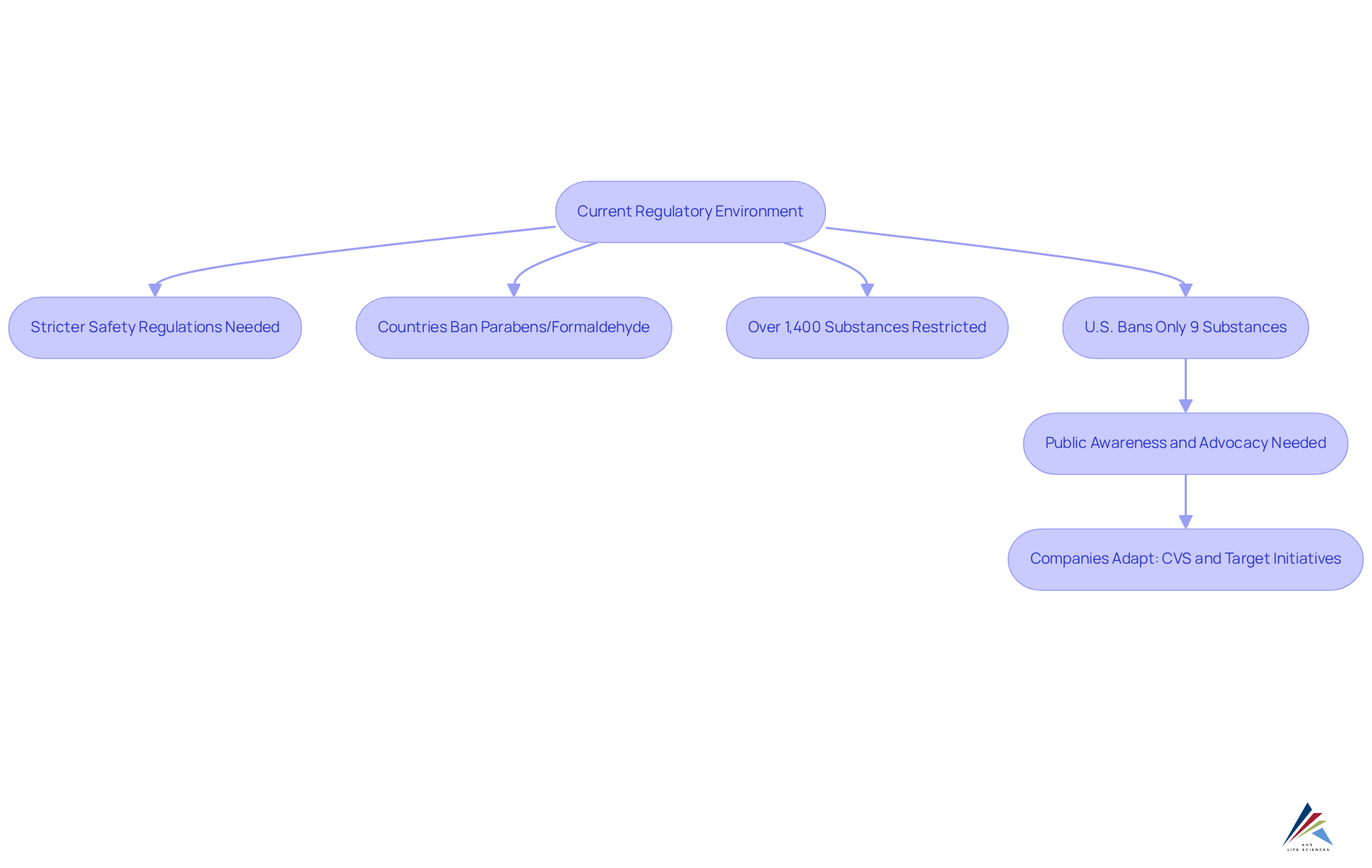
Transparency in Labeling: Empowering Consumers to Make Safe Choices
Clarity in labeling is paramount for about the cosmetics they choose. that highlight the absence of parabens and formaldehyde are crucial for guiding consumers towards , particularly with the implementation of the .
are increasingly parabens/formaldehyde cosmetics bill, which not only bolsters but also promotes safer practices within the industry. Companies that prioritize not only comply with regulations but also foster loyalty among , reinforcing their .
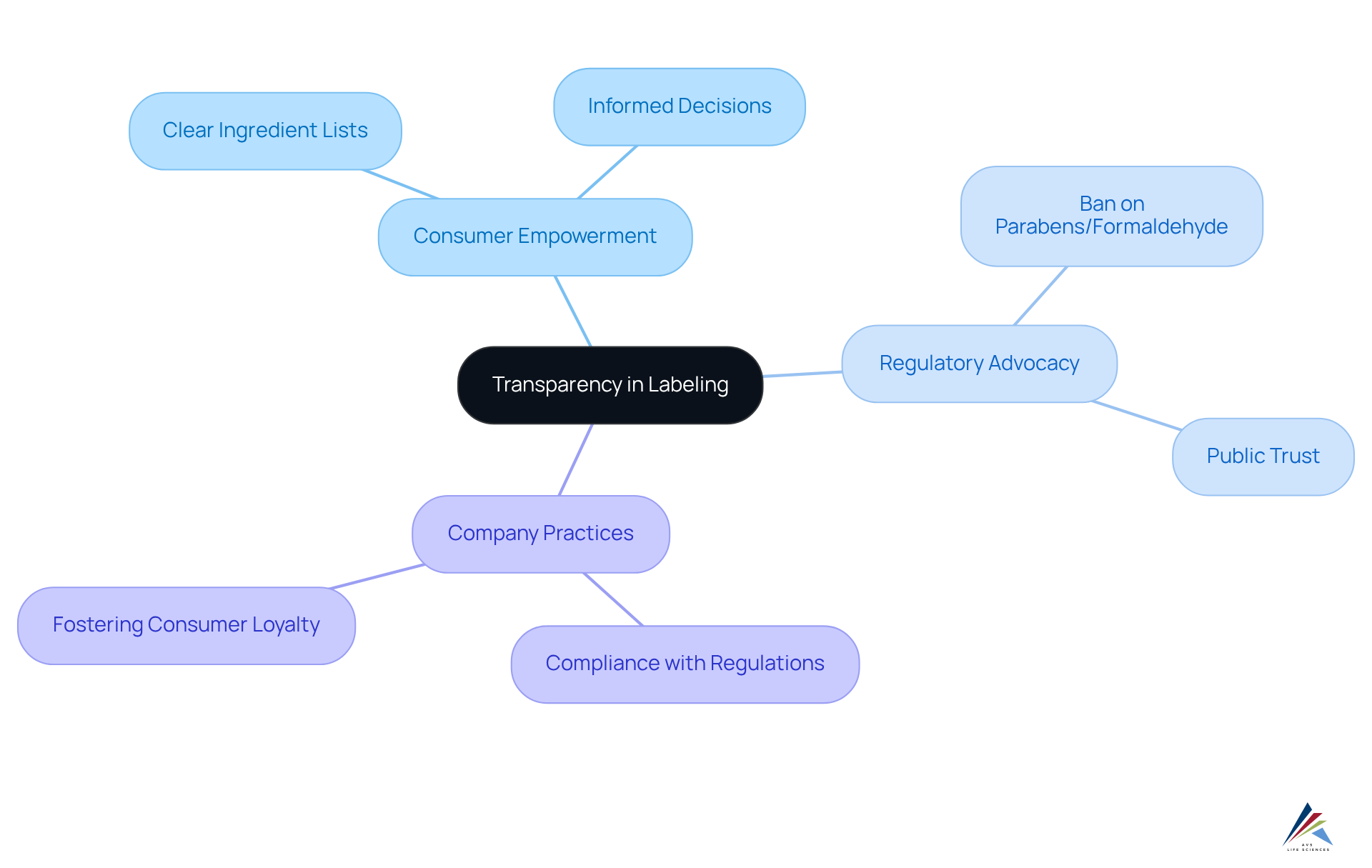
Economic Benefits: How the Ban Can Boost Consumer Trust and Market Growth
The offers substantial economic advantages for the cosmetics industry. By eliminating these harmful components, companies can significantly enhance trust among buyers, tapping into a rapidly growing market of . This transition is particularly evident in the , which saw a remarkable 33% sales increase in the first half of 2021, reaching $1.6 billion, largely driven by the demand for safer products. Notably, both skincare and makeup categories grew by more than 20% during this period, highlighting robust growth in these segments. As consumers increasingly prioritize —68% expressing a desire to purchase skincare products made with clean ingredients and 40.2% considering them essential when shopping— are poised to experience heightened sales and market expansion.
Moreover, companies that proactively adhere to , including the ban parabens/formaldehyde cosmetics bill, not only mitigate potential liabilities but also bolster their brand reputation. This strategic positioning can yield a in a market where the ban parabens/formaldehyde cosmetics bill is vital for maintaining public trust. Analysts note that brands embracing are better equipped to cultivate and enhance sales, ultimately contributing to a more resilient and sustainable beauty industry. In fact, 74% of consumers are more inclined to make purchases from companies that feature reviews on their websites, underscoring the critical role of transparency in building consumer trust. Furthermore, the is projected to reach $22 billion by 2024, signifying significant growth opportunities for brands that prioritize safety and compliance.
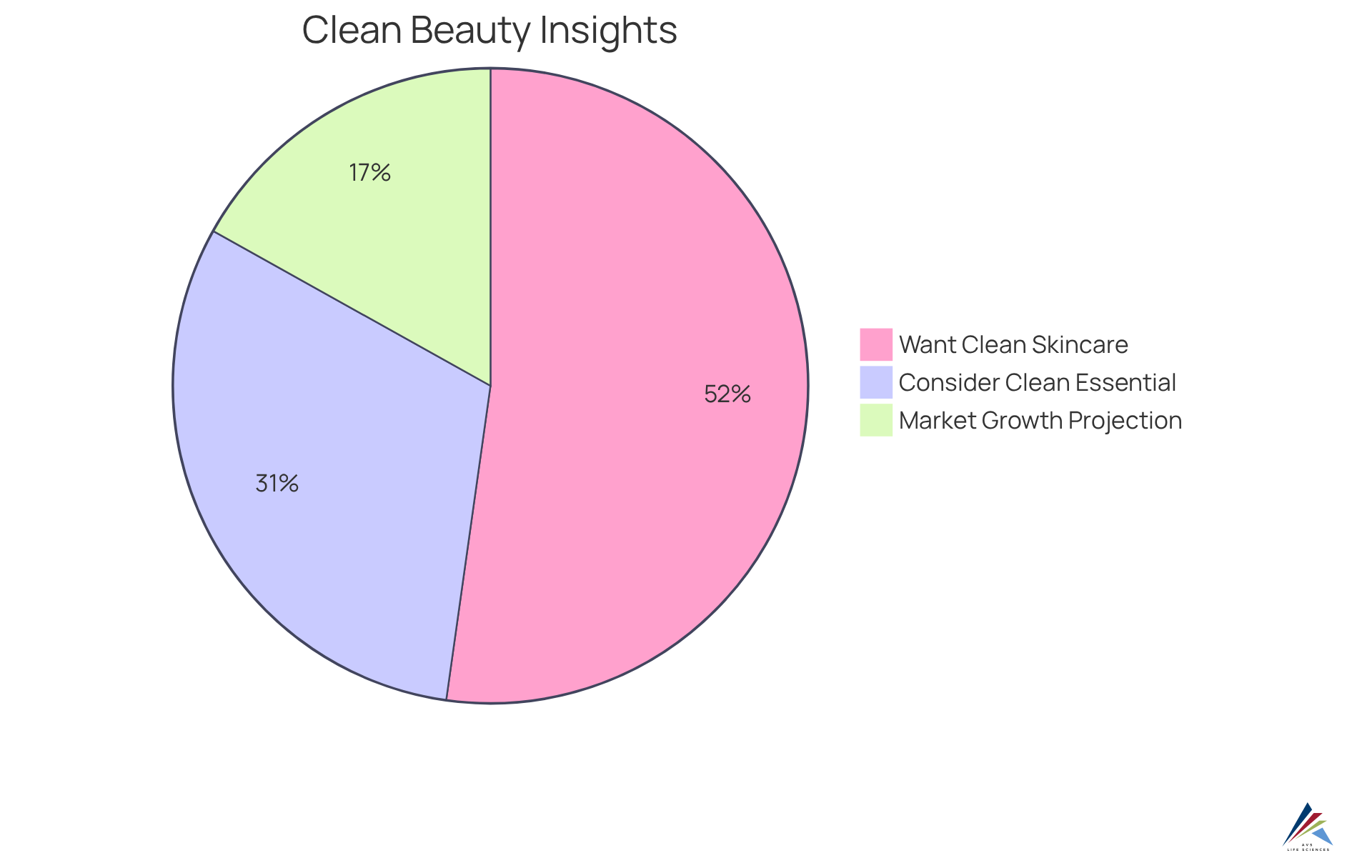
Scientific Research: Evidence Supporting the Ban on Harmful Cosmetic Ingredients
Extensive scientific research underscores the and formaldehyde, reinforcing the imperative for their prohibition in beauty products. Parabens, commonly employed as preservatives, have been shown to mimic estrogen, potentially disrupting hormonal balance and leading to reproductive issues. Notably, studies reveal that elevated urinary concentrations of methylparaben (MP) and ethylparaben (EP) in women correlate with a 37% decline in couple fecundity, emphasizing their endocrine-disrupting effects.
Formaldehyde, another prevalent ingredient in beauty products, raises substantial health concerns, including respiratory issues and an increased cancer risk. Epidemiological studies have established a link between formaldehyde exposure and various health complications, further necessitating stringent regulations. The evidence is compelling: approximately 39.3% of beauty products contain these harmful substances, with 11.5% of soaps and nearly 40% of items, such as moisturizers and sunscreens, incorporating preservatives.
Case studies further illuminate the hazards posed by these chemicals. For instance, research indicates that prolonged exposure to formaldehyde can lead to chronic respiratory conditions, while certain preservatives have been associated with an due to their ability to disrupt estrogen signaling pathways. Expert opinions stress the to protect public health. Yao Xiong notably cautioned against the use of personal care items containing phenols, particularly for individuals at higher risk for breast cancer.
Utilizing this scientific evidence, stakeholders can effectively advocate for the , which aims to , thus promoting safer alternatives that prioritize public safety. Additionally, is essential for enhancing user protection.

Innovation Opportunities: Developing Safer Alternatives to Parabens and Formaldehyde
The movement for the presents a pivotal opportunity for innovation in the cosmetics industry. Manufacturers are increasingly motivated to explore and develop safer alternatives that uphold . , such as essential oils and plant extracts, are becoming effective alternatives, indicating an increasing preference for .
In 2021, experienced a remarkable growth rate of 8.1%, underscoring the demand for . Companies investing in research and development are not only meeting consumer safety expectations but also enhancing product performance. For example, Chemipol introduced the SENSICARE C 2060 product line, which provides antimicrobial features intended to safeguard beauty formulations.
Industry leaders emphasize the importance of this shift, with many advocating for the and the adoption of to ensure both safety and effectiveness in cosmetic products. Significantly, a Nielsen survey showed that 40.2% of shoppers prioritize natural ingredients when purchasing beauty products.
As the market evolves, the trend towards natural preservatives is expected to gain momentum, with projections indicating , expected to rise from USD 1,124.6 million in 2025 to USD 2,831.8 million by 2034.
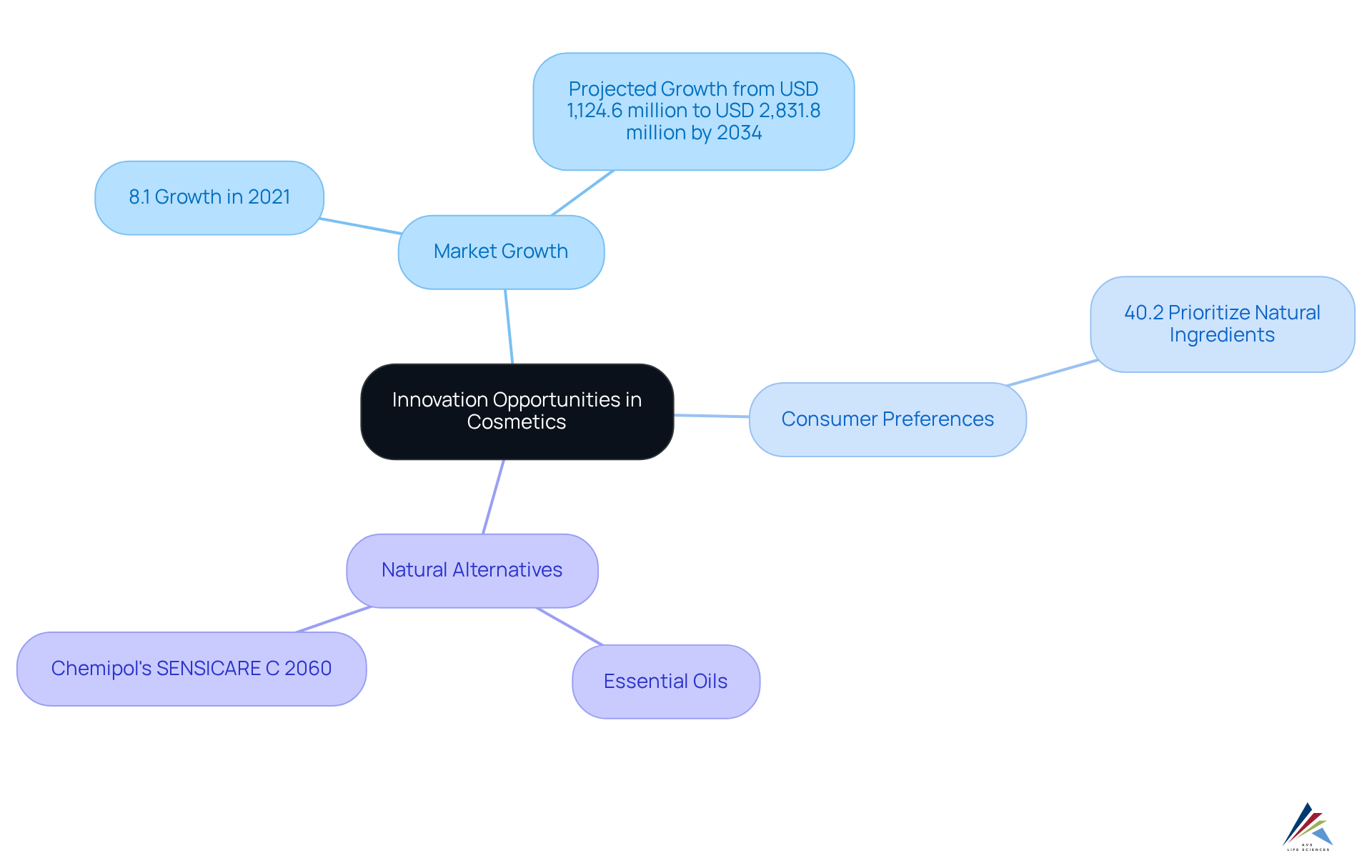
Collective Benefits: Enhancing Consumer Safety and Well-Being Through the Ban
The combined advantages of the extend beyond personal wellness; they significantly enhance overall societal well-being. By prioritizing , the can cultivate a healthier population and alleviate the burden on healthcare systems associated with chemical exposure.
For instance:
- Hormone-disruptive plastic substances alone accounted for over $249 billion in .
- PFAS chemicals contributed an additional $22 billion in medical costs.
- Phthalates resulted in $67 billion in medical expenses during the same year, underscoring the financial strain linked to hazardous products.
Promoting safer cosmetics not only mitigates these costs but also fosters greater trust and loyalty among consumers, ultimately benefiting the industry as a whole. Public wellness specialists, such as Dr. Sheela Sathyanarayana, emphasize that these regulatory modifications are crucial for , particularly women of color, who are disproportionately affected by toxic substances in marketed products.
As the industry transitions towards , stakeholders must acknowledge these collective benefits to advocate effectively for necessary regulatory reforms, including the recently enacted ban parabens/formaldehyde cosmetics bill, which protects and enhances consumer well-being.
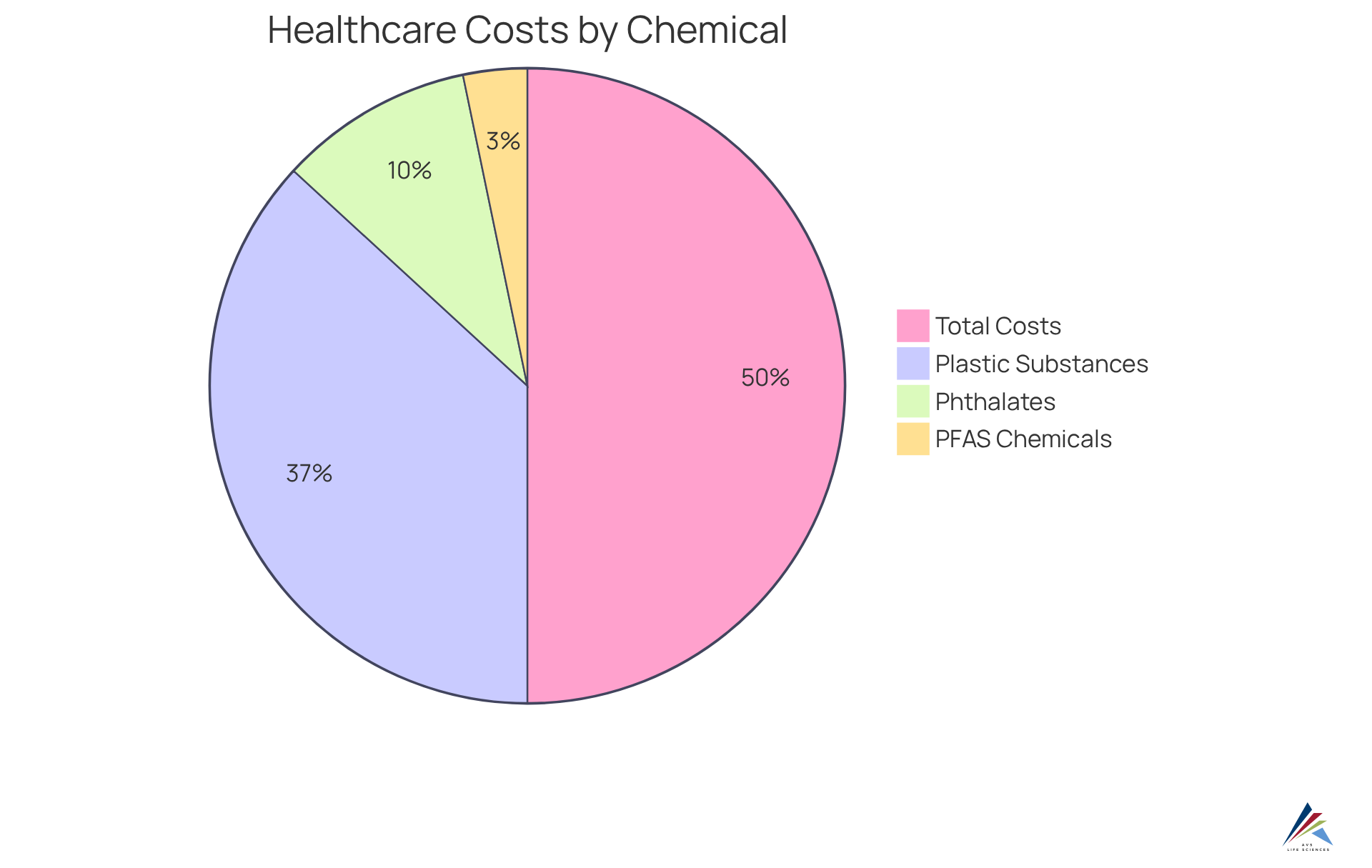
Conclusion
The imperative to ban parabens and formaldehyde in cosmetics is underscored by the myriad of health, environmental, and economic benefits that such a prohibition would entail. These harmful preservatives pose significant risks to human health, including hormone disruption and cancer, while also jeopardizing ecosystems through pollution and toxicity. This article highlights the critical need for regulatory change, emphasizing that consumer advocacy and scientific research are pivotal in driving these necessary reforms.
Key arguments presented include the alarming prevalence of these substances in beauty products, the growing consumer demand for clean and safe alternatives, and the economic advantages of fostering a transparent and trustworthy market. As awareness about the dangers of parabens and formaldehyde increases, the call for stricter regulations becomes more urgent, reflecting a collective push towards a safer future in the cosmetics industry.
In conclusion, supporting the ban on parabens and formaldehyde transcends individual safety; it promotes a healthier society and environment as a whole. Stakeholders across the board—consumers, manufacturers, and regulators—must unite in this endeavor, recognizing that the transition to safer cosmetics will ultimately lead to improved public health outcomes, economic growth, and a sustainable beauty industry. The time to act is now, ensuring that future generations can enjoy cosmetics that are both effective and safe.
Frequently Asked Questions
What role does AVS Life Sciences play in the cosmetics industry regarding the ban on parabens and formaldehyde?
AVS Life Sciences assists cosmetic producers in navigating the complexities of the ban on parabens and formaldehyde by providing comprehensive regulatory, compliance, and quality solutions. They conduct thorough audits, offer tailored training programs, and ensure meticulous documentation to help clients meet current regulations.
What are the FDA and EU regulations regarding parabens and formaldehyde?
The FDA classifies parabens and formaldehyde as Generally Recognized as Safe (GRAS) at concentrations up to 25%. In contrast, the European Union has set limits of 0.4% for any individual compound and 0.8% for total concentrations of these preservatives.
What specific regulations has the Danish government implemented concerning preservatives in cosmetics?
The Danish government has prohibited the use of certain preservatives in personal care products designed for children under three years, highlighting the importance of the ban on parabens and formaldehyde in cosmetics.
What health risks are associated with parabens and formaldehyde in cosmetics?
Parabens and formaldehyde pose significant health risks, including hormone disruption, reproductive issues, and an increased risk of cancer. Research indicates that parabens can penetrate the blood-brain barrier, and formaldehyde is classified as a known carcinogen, potentially causing skin irritation and respiratory problems.
How prevalent are parabens and formaldehyde in the U.S. population?
Research shows that over 90% of the U.S. population has measurable amounts of parabens and formaldehyde in their bodies, raising concerns about the long-term effects of exposure.
What environmental concerns are associated with the use of parabens and formaldehyde in cosmetics?
Parabens can accumulate in aquatic systems, disrupting reproductive systems in fish and affecting essential physiological functions in indicator species like daphnids. Formaldehyde can inhibit plant growth and reduce biodiversity in terrestrial ecosystems, impacting the entire food web.
Why is the ban on parabens and formaldehyde in cosmetics important for the environment?
The ban is crucial for protecting human health and the environment by reducing or eliminating harmful substances that can disrupt aquatic ecosystems and biodiversity, promoting sustainable practices within the beauty industry.
